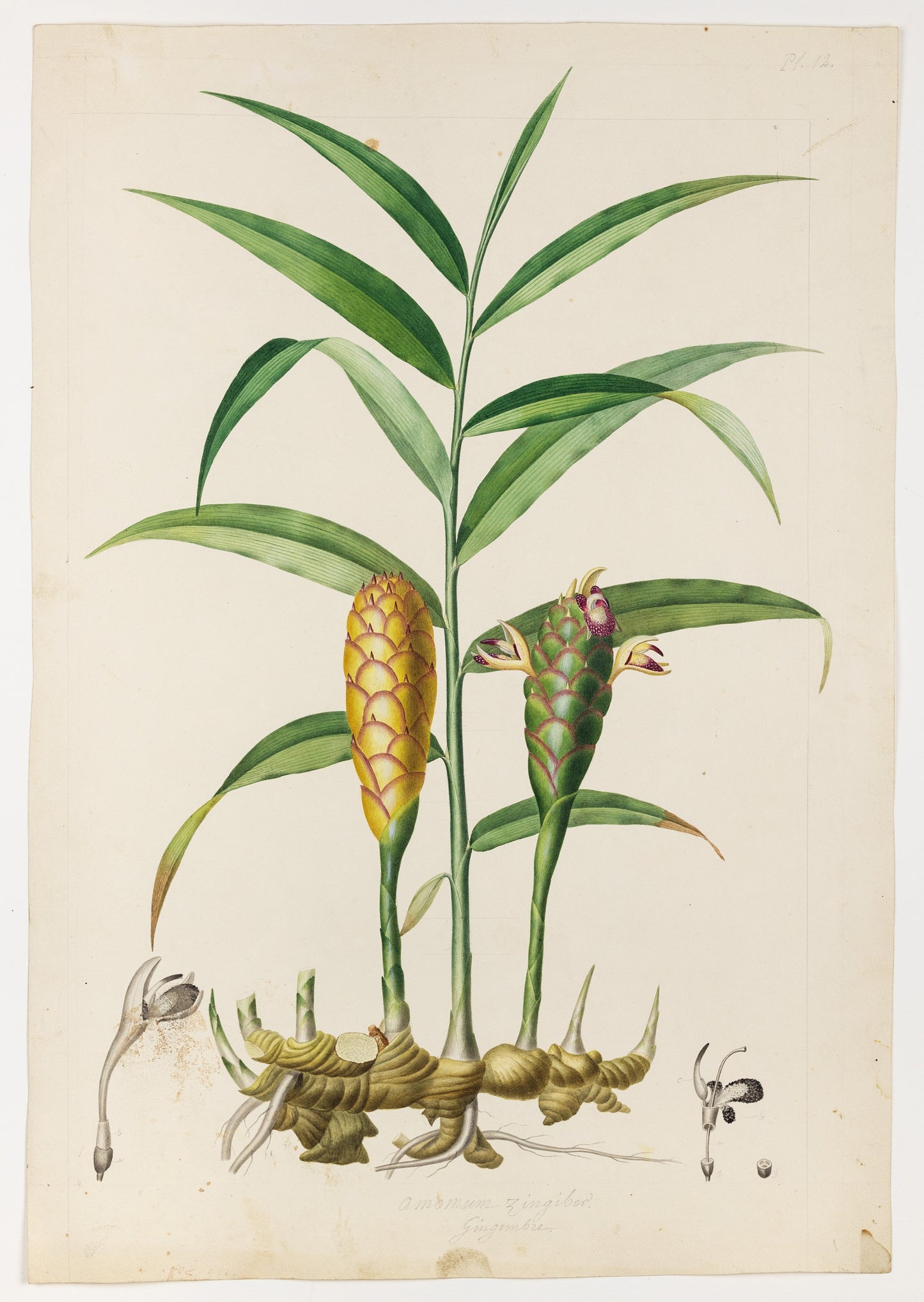from: Poiteau & Turpin Superb Botanical Drawings including varieties from the West Indies
PIERRE JEAN FRANÇOIS TURPIN (FRENCH, 1775 - 1840). Ginger.
PIERRE JEAN FRANÇOIS TURPIN (FRENCH, 1775 - 1840). Ginger.
Couldn't load pickup availability
PIERRE JEAN FRANÇOIS TURPIN (FRENCH, 1775 - 1840)
“Amomum zingiber” [Zingiber officinale. Ginger]
Preparatory drawing for F.R. Tussac. Flore des Antilles, ou histoire générale botanique, rurale et economique des végétaux indigènes des Antilles.
Paris: chez l’auteur, F. Schoell et Hautel, 1808–1827
Vol. 3 Pl. 13
Watercolor and pencil on paper
Paper size:
Tussac wrote of this plant,
“Ginger is cultivated and only succeeds in the mountains, where it is so naturalized that it has spread to some areas, from which it has excluded all other plants. It is cultivated as follows: when the land has been sufficiently plowed with a hoe and cleaned of weeds, holes are made two to three inches deep, half a foot apart from each other, a piece of ginger root is placed in each hole, and covered with the foot. A year later, the roots are dug, the stems of which are cut, they are well cleaned, by washing, of the earth which surrounds them, the first skin is scraped, then they are plunged into boilers of boiling water, with the effect of destroying the vital principle; for this operation, baskets of lianas are used which are suspended above the boilers, and which, by means of a rope passed through a line, can be lowered and raised at will; the roots of ginger are thus subjected to several immersions, until it is assumed that the vital principle is destroyed; without this operation, the roots would not fail to vegetate, which would dispose them to a fermentation which would cause their decomposition and destruction. After this operation, the ginger is carried to the glacis on which it is dried; it is stretched well, and left in the sun until it is judged to be deliverable to the trade. One reason this cultivation is sometimes abandoned, is that this plant deteriorates the soil so much that for several years in a row, no other plants can grow there, and it is infinitely difficult to uproot the ginger, because there always remain a few pieces of roots which reproduce it. Mr. de Lamothe, a colonist of Jamaica, has invented a means of stripping ginger roots of the gray film which covers them, which is not only useless, but also disposes the roots to be attacked by insects which hide beneath. For this operation, he uses a barrel whose inner surface is covered with a sheet metal lining in the shape of a grater; a second lining, also in grater form, is placed three inches apart from the first; it is in this interval that the ginger roots are placed; the barrel is then moved, either by means of a cau (?), or by a crank set; the rotation of the barrel causing the roots to rub against the graters continually, the epidermis is detached, and they become perfectly white; then they are taken out of the barrel, and carried to the sun or to an oven to dry them. Thus prepared, ginger keeps for a very long time, and is not attacked by worms. Care must be taken to fill the barrel in which the white ginger is prepared almost full of water; without this precaution, the film which comes off the roots would clog the graters, and prevent their effect; The water used contains an acrid, burning, heavy oil to the point of sinking to the bottom of the water: this oil is used in fomentations against rheumatic pains.”
Appeared in F.R. Tussac. Flore des Antilles, ou histoire générale botanique, rurale et economique des végétaux indigènes des Antilles.
Paris: chez l’auteur, F. Schoell et Hautel, 1808–1827
Study for Vol. 3, Plate 12



